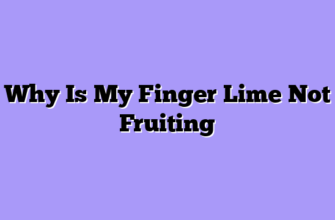When I first heard about finger limes back in 2014, I thought they were just another overhyped exotic fruit that would never work in Florida’s challenging climate. Boy, was I wrong. After ten years of growing these Australian natives in the Sunshine State, I can tell you with absolute certainty that not only can finger limes grow in Florida – they can absolutely thrive if you know what you’re doing.

I remember my first casualties – three beautiful Red Champagne finger lime trees that I treated exactly like my Meyer lemons. Within six months, they were dead as doornails, victims of my ignorance about their specific requirements. That $300 lesson taught me that Florida might be perfect for citrus, but finger limes play by entirely different rules.
The question isn’t really whether finger limes can grow in Florida – it’s whether you’re willing to adapt your growing methods to meet their unique demands. And trust me, once you crack the code, these little citrus caviar producers will reward you in ways that’ll make your neighbors green with envy.
Florida’s Climate Challenge: Working With What You’ve Got
Florida’s subtropical climate presents both opportunities and obstacles for finger lime cultivation. On the positive side, we’ve got year-round growing potential, abundant sunshine, and generally warm temperatures that these Australian natives appreciate. But here’s where it gets tricky – finger limes evolved in the rainforests of Queensland and New South Wales, where they experienced consistent moisture, filtered sunlight, and stable temperatures.
Our Florida summers, with their brutal heat, intense UV rays, and afternoon thunderstorms, can stress these trees faster than a tourist stuck in I-4 traffic. I learned this during my second year when a particularly vicious July heat wave pushed temperatures to 98°F for two weeks straight. My unprotected finger lime trees looked like they’d been through a war zone – leaves curled, fruit dropped, and growth completely stalled.
The humidity factor is equally complex. While finger limes appreciate consistent moisture, Florida’s combination of high humidity and poor air circulation creates perfect conditions for fungal diseases. I’ve battled everything from anthracnose to citrus canker, and let me tell you, prevention is infinitely easier than treatment.
But here’s the thing – every challenge has a solution if you’re creative enough. I started thinking of my finger lime grove like a microclimate within Florida’s larger ecosystem. Instead of fighting the environment, I learned to modify it.
Key Florida growing challenges and my solutions:
- Intense summer heat → 40% shade cloth during peak summer months
- Hurricane-force winds → Strategic windbreak plantings and flexible support systems
- Fungal diseases → Improved air circulation through proper spacing and pruning
- Soil drainage issues → Raised beds with custom soil mixes
- Pest pressure → Integrated pest management with beneficial insects
Varieties That Actually Work: Not All Finger Limes Are Florida-Friendly
After years of trial and error, I’ve discovered that variety selection makes or breaks your Florida finger lime operation. Some cultivars handle our climate like champs, while others struggle no matter how much attention you give them.
My absolute superstar performer has been the Collette variety. This green-fruited beauty seems almost designed for Florida conditions – it handles heat better than my other varieties, shows good disease resistance, and produces consistently even during challenging weather. I’ve got trees that are now seven years old and still going strong, producing fruit that commands $12-15 per pound at local farmers markets.
The Pink Ice variety surprised me with its adaptability. Initially, I was skeptical because pink varieties often struggle in high-heat climates, but this one proved me wrong. It fruits reliably, handles our summer storms well, and the pink pearls inside create an incredible visual impact that chefs absolutely love.
Here’s my recommended planting timeline for Florida finger lime success:
- Site preparation (September-October): Choose location with morning sun, afternoon shade
- Soil amendment (October-November): Create raised beds with drainage-focused soil mix
- Planting (November-January): Cool season establishment reduces transplant shock
- First year protection (Year 1): Shade cloth, wind protection, careful watering
- Maturation phase (Years 2-3): Gradual acclimation to full Florida conditions
- Production phase (Years 3-5): Full fruit production with proper management
The varieties I’ve had less success with include some of the more delicate Australian selections that simply can’t handle our extreme weather swings. Byron Sunrise looks gorgeous in catalogs but struggled with our humidity levels. Similarly, some of the premium red varieties that perform beautifully in California greenhouses became disease magnets in Florida’s open-air conditions.
| Variety | Heat Tolerance | Disease Resistance | Production Level | Market Price/lb |
|---|---|---|---|---|
| Collette | Excellent | Very Good | High | $12-15 |
| Pink Ice | Very Good | Good | Medium-High | $15-18 |
| Red Champagne | Good | Fair | Medium | $18-22 |
| Alstonville | Fair | Good | Low-Medium | $15-18 |
| Crystal | Poor | Fair | Low | $20-25 |
The Economics of Florida Finger Limes: Is It Worth the Investment?
Let’s talk money, because that’s ultimately what determines whether any crop makes sense for commercial production. Finger limes in Florida represent what I call a “boutique crop opportunity” – high value per pound, but requiring significant expertise and initial investment.
My production costs are considerably higher than traditional Florida citrus. Between specialized soil amendments, shade structures, irrigation systems, and pest management, I’m looking at roughly $2,500 per mature tree to get established. That sounds scary until you consider that a single productive tree can yield 20-40 pounds of fruit annually, selling for $12-25 per pound depending on variety and market timing.

But scaling up presents challenges. Unlike traditional citrus that you can plant by the acre and manage mechanically, finger limes require individualized attention. Each tree has its own personality, its own needs, and its own production patterns. I’ve found that my sweet spot is around 50-75 trees – enough to generate meaningful revenue, but not so many that quality suffers.
The seasonal nature of Florida finger lime production actually works in our favor. We’re producing fresh fruit during months when Australian imports are limited, allowing us to command higher prices. My peak harvest runs from October through February, perfectly timed for the restaurant industry’s busy season.
Market development has been crucial to my success. I didn’t just plant trees and hope customers would appear – I actively cultivated relationships with chefs, high-end grocery stores, and fellow farmers market vendors. I provide recipe cards with each sale, offer cooking demonstrations, and maintain an email list of customers who want to know when specific varieties become available.
The Reality Check: What Success Actually Looks Like
After ten years of growing finger limes in Florida, I want to give you the unvarnished truth about what success looks like. It’s not Instagram-perfect rows of uniformly productive trees. It’s a constant dance of observation, adjustment, and problem-solving that requires genuine passion for the crop.
My most successful years have been the ones where I stopped trying to make finger limes behave like traditional citrus and started working with their natural tendencies. That meant accepting that some varieties would never work in my specific microclimate, that production would be variable year to year, and that every tree would require individual attention.
The financial returns have exceeded my expectations, but not in the way I initially imagined. Instead of competing on volume like traditional citrus operations, I’ve built a reputation for quality that allows premium pricing. My finger limes sell for 10-15 times more per pound than oranges, and I have customers who pre-order their annual supply.
The biggest surprise has been the secondary opportunities that finger lime growing has created. I now consult for other exotic fruit growers, sell grafted trees to hobbyists, and even offer “finger lime growing workshops” that generate additional revenue streams. Success in boutique agriculture often comes from diversification rather than specialization.
Would I recommend finger lime growing to other Florida farmers?
Absolutely, but with important caveats. You need patience, attention to detail, and enough capital to absorb some initial losses while you learn. This isn’t a crop for farmers looking for quick returns or passive income. But for those willing to invest the time and effort, finger limes offer an opportunity to build a profitable, sustainable operation that stands out in Florida’s crowded agricultural landscape.
The key is approaching finger limes not as an exotic experiment, but as a legitimate crop with specific requirements that happen to be different from what we’re used to. Once you make that mental shift, success becomes not just possible, but probable.








